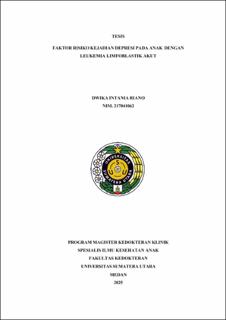| dc.description.abstract | Background: Depression is a common psychiatric disorder, one of the symptoms
of which is depressed mood or anhedonia, which is a loss of interest or pleasure.
Several previous studies have evaluated depression in pediatric LLA patients with
highly variable results resulting from differences in factors evaluated, sample
characteristics and screening instruments used.
Objective: To analyze the risk factors for depression in children with acute
lymphoblastic leukemia using PHQ-9.
Methods: Cross sectional study to assess the level of depression in children with
acute lymphoblastic leukemia in the outpatient unit at the Haji Adam Malik
Central General Hospital Medan in the period August 2024 to October 2024. All
children in the age group of 7-18 years were diagnosed with acute lymphoblastic
leukemia.The incidence of depression in children was assessed with the PHQ-9
questionnaire. Categorical data were displayed as proportions. The association of
risk factors with depression was analyzed using chi square test, bivariate analysis
was used to identify associated variables and multivariate analysis was performed
using logistic regression test to assess the probability of depression.
Results: 40 subjects have been recruited in this study, there is an association of
age group (p=0.002), type of leukemia (p=0.004), and mode of therapy (p=0.003)
on the occurrence of risk factors for childhood depression. In this study, the most
significant risk factor for depression in children was age group, followed by the
mode of therapy and type of leukemia. Conclusion: Assessment of depression in
leukemia children can be done using depression screening instruments, where age
group, type of leukemia and mode of therapy are risk factors for depression in
children with leukemia. | en_US |


